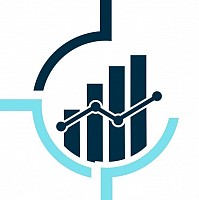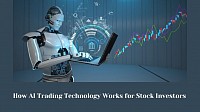Blog
How AI Trading Technology Works for Stock Investors [Guide]
Are you curious about the force driving rapid stock market decisions, where split seconds shape fortunes? In a landscape characterized by complexity and volatility, the role of artificial intelligence in trading has become increasingly prominent.
In the dynamic realm of financial markets, investors increasingly turn to technology as a powerful ally, enhancing their ability to gain a competitive advantage in trading.
Incorporating artificial intelligence (AI) into stock trading has marked a revolutionary leap, showcasing a remarkable Compound Annual Growth Rate (CAGR) in recent years.
This article aims to shed light on the workings of AI trading technology, demystifying its complexities for investors eager to harness its potential.
What is AI Trading Technology?
AI trading technology seamlessly integrates finance and cutting-edge computing, aiming to swiftly analyze extensive financial data, recognize patterns, and execute trades with unparalleled efficiency.
In contrast to human-centric methods, AI trading relies on algorithms and machine learning, utilizing real-time market data and historical stock behavior to predict short-term price movements.
This automated quantitative approach, distinguished by adaptability to market changes, ensures continuous learning from new data, making AI trading a sophisticated and responsive tool for navigating the intricacies of financial markets.
How AI Trading Technology Works: A Step-by-Step Guide
Utilizing sophisticated algorithms and machine learning, AI trading technology enables stock investors to make well-informed investment decisions.
Here's a step-by-step breakdown of how it works:
Step 1: Data Collection
AI trading systems gather vast amounts of financial data from diverse sources, including market prices, economic indicators, news, and social media.
Step 2: Data Processing
The collected data undergoes rigorous analysis through statistical models and machine learning algorithms. These algorithms identify patterns, trends, and correlations that might be imperceptible to human investors.
Step 3: Pattern Recognition
AI systems excel at recognizing complex patterns in historical market data. They identify signals that could indicate potential future price movements or market trends.
Step 4: Algorithmic Trading Strategies
Based on the identified patterns, AI develops algorithmic trading strategies. These strategies automatically execute buy or sell orders, optimizing trading decisions in real time.
Step 5: Risk Management
AI incorporates risk management algorithms to minimize potential losses. It calculates the risk associated with each trade and adjusts the portfolio accordingly.
Step 6: Continuous Learning
AI trading systems continuously learn from new data and adjust their strategies accordingly. This adaptive learning process ensures that the algorithms stay relevant in dynamic market conditions.
Step 7: Execution
Once a trading strategy is determined, AI executes trades swiftly and efficiently, taking advantage of market opportunities within milliseconds.
Step 8: Performance Monitoring
The AI system monitors its own performance, evaluating the success of previous trades. This feedback loop allows for ongoing refinement and improvement of the trading algorithms.
AI trading technology combines data analysis, machine learning, and algorithmic execution to provide investors with data-driven insights and automated trading strategies, enhancing decision-making and potentially optimizing investment returns.
Benefits of AI Trading Technology:
- Speed and Efficiency:
AI trading systems operate at speeds measured in microseconds, enabling them to execute trades much faster than human traders. This speed is crucial in capturing fleeting market opportunities. - Emotion-Free Trading:
The influence of emotions on judgment, leading to impulsive decisions, is mitigated by AI trading. This technology eradicates emotional biases, promoting a trading approach that is rational and disciplined. - Continuous Learning:
Machine learning algorithms continually adapt and improve based on new data. This allows AI trading systems to evolve and enhance their performance over time. - 24/7 Monitoring:
Unlike human traders who need rest, AI systems can operate 24/7, monitoring markets around the clock and reacting to global events in real time.
What are the Strategies for AI Trading?
In today's trading landscape, diverse strategies leverage AI-driven systems, including algorithmic trading, which employs computer programs to execute trades automatically following precise instructions.
- Quantitative Analysis:
AI employs quantitative models to evaluate financial data, using statistical techniques to identify trends and correlations. This data-driven approach helps in making more objective investment decisions. - Sentiment Analysis:
AI analyzes news articles, social media, and other textual data to gauge market sentiment. This sentiment analysis aids in understanding public perception and can influence trading decisions.
- Arbitrage Opportunities:
AI identifies price differentials across different markets and executes trades to exploit these discrepancies. This strategy capitalizes on market inefficiencies for potential profits.
- Machine Learning Predictions:
AI employs machine learning models to predict future price movements based on historical data. These predictions inform trading decisions, helping traders anticipate market trends.
Final Words
AI trading technology revolutionizes stock investing by leveraging advanced algorithms and real-time data analysis.
It empowers investors with timely insights, risk management, and automated decision-making.
As markets evolve, embracing AI-driven tools becomes imperative, offering a competitive edge in navigating the dynamic landscape of stock trading with precision and efficiency.


